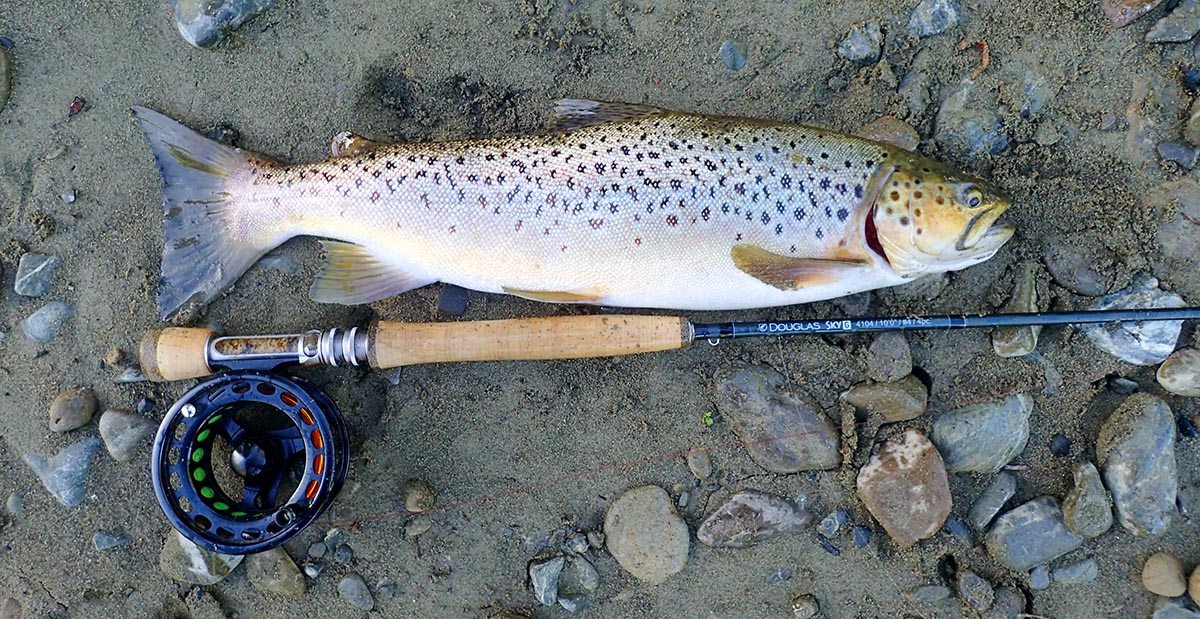Euro nymphing may not fit everyone’s definition of fly fishing but it’s deadly effective on the right water and according to some a lot of fun. ‘Don’t knock it till you try it’, they say.
I toyed with giving Euro nymphing a go for sometime, perhaps because of the similarities to slow jigging for snapper which I thoroughly enjoy, but it was the idea of fishing jig streamers on a mono rig that finally edged me to look for a suitable rod.
A deep dive into the internet suggested a 10.5 foot 3 wt would be the ultimate dedicated euro nymphing rod for New Zealand rivers, but a 10 ft 4wt was likely better for jig streamers, regular floating lines for larger flies and perhaps even a light Skagit head - so promised to be more than a dedicated Euro nymphing rod.
Having set my sights on a 10 ft 4wt Euro rod, the stars aligned, largely due to unforeseen circumstances, and I was given the opportunity to test the brand new Sky G 4104, released in 2023.
Out of the tube
The Sky G 10 ft 4wt has the same matt grey blank and black wrap colour scheme as all Sky G rods, including my 9 ft 5wt, and the blank is made and coated using the same impressive graphene technology. The finish, including cork on the half wells grip, is also of the same high standard.
My year long experience with the Sky G 9 ft 5wt and with the 4104 showed that the matt grey coating does not scratch like the varnish on other top end rods I own, including rods from Loomis, Sage and Hardy. I am often forced to rest my rods on boulders or gravel on New Zealand rivers, especially while changing flies or releasing fish.
Although all Sky G rods use top end indestructible REC titanium guides, there are some differences between the nymphing rods and the rest of the series.
First off, they have snake guides instead of single foot guides, which happen to be very thin and light. Secondly, the snake guides (12 in total) are spaced closer together than is standard, and the single REC Titanium Cerecoil stripper guide with zirconia insert is found further down the butt to reduce line sag and thin wet lines sticking to the rod.
Although the Sky G 4104 has the same reel seat as my Sky 9ft 5wt, it is down locking instead of up locking to provide better balance with lighter reels for short line nymphing.
The rod balances perfectly with a Danielsson F3W 4seven fly reel, which weighs 5.2 ounces without any line on it. This reel also balances the shorter 9 ft 5wt with a down locking reel seat.
Below the reel seat is a large fighting butt that, for me, has three important functions: 1) to brace the rod whilst nymphing/jigging; 2) fighting decent fish, and 3) keeping large arbor reels off the ground when the rod is leaning against some structure, e.g. a wall, car or tree.
Rod Action
The first thing I did when I put the 10 ft rod together was the flex test demonstrated by Devin Olsen (Tactical Fly Fisher) in his excellent video on choosing a Euro Nymphing rod. The flex test revealed the Sky G 4104 had a powerful but flexible butt and soft tip with smooth/progressive transition between the two. It struck me that the flex profile was not dissimilar to my 12 ft 5wt Orvis Mission Spey rod, but on a micro level.
Other important information from the flex test was : fast recovery, very quick dampening for a flexible 10 ft rod and an unbelievably light swing weight - it felt like a feather compared to my 9.5 ft 5wt Sage X and my mate’s 10 ft Primal Zone 4wt.
The butt section on the Sky G has more flex than the Primal Zone, so is not as powerful and flex from tip to butt is more progressive.
Euro Nymphing
I tried a number of different euro lines on the Sky G, including: a mono rig based on a main line of 20 lb Maxima Chameleon; a SA Euro kit, which consists of a short 20 ft braid core level euro line with a tapered euro leader, and a braided core Tactical Euro Nymph line with hand-tied leaders.
A mono rig basically uses a long length of nylon monofilament instead of a fly line. Maxima Chameleon (not Ultra Green) is a popular choice for mono rigs because it’s stiff for turn over but has little memory once stretched.
When it comes to the thickness of mono rigs, two versions are commonly used: the first is ultra thin and based on around 6 lb Maxima and the second based on 20 lb Maxima.
Thicker monofilament produces better turn over and accuracy, particularly with heavier flies, while thin mono has less line sag and is more sensitive when euro nymphing, especially with lighter flies.
There are two reasons to fish with coated euro lines:
1) mono rigs are illegal in competitions and in New Zealand’s Taupo fishery, and
2) some anglers prefer the feel of fly line over mono.
My mono rig and leader designs for coated lines are borrowed from those of Devin Olsen, George Daniels and Domenick Swentosky; but because I could not get Amnesia or gold Suffix Elite of the required breaking strains in New Zealand, I had to make some modifications.
I used two leaders on the Tactical Euro Nymph line for nymphing, one based on 12 lb and the other on 20 lb Maxima Chameleon.
Leader 1:
• 9 ft of 20 lb Chameleon,
• 3 ft of 14 lb Maxima HV yellow with a backing barrel sighter (see link at end of article),
• 1.5 ft of 0x SA absolute Tri-colour sighter,
• Tippet ring
• 4-5x fluorocarbon tippet.
Leader 2:
• 11 ft of 12 lb Chameleon with backing barrel sighter
• 2 ft of 0x SA absolute Tri-colour sighter,
• Tippet ring
• 4-5x fluorocarbon tippet.
The leaders for the coated line were designed to be no longer than 19.7 ft (6 m) with 6 feet of tippet - to comply with Taupo fishery rules. The section of 14 lb Maxima on the heavier leader reduces sag and improves visibility.
The leader for nymphing on the Mono Rig was as follows:
• 50 ft of 20 lb Maxima Chameleon
• 3 feet 14 lb Maxima High Visibility yellow with backing barrel.
• Tippet ring
• 1.5 ft of 0x or 2x SA absolute Tri-colour sighter
• Tippet ring
• 4-5x fluorocarbon tippet
Having a tippet ring between the Maxima HV and the sighter on the mono rig enables me to quickly switch from nymphs to streamers and visa versa. I simply remove the Tri-colour sighter, the 4-5X tippet and nymphs store them on a foam rig winder, then add 5 ft of 3X tippet and a jig streamer to the tippet ring.
The Sky G 4104 performed equally well with all of the line set-ups I tested. Being used to handling mono running lines for Spey Casting I had little trouble with the 20 lb nylon used for the mono rig.
I could cast 3.0mm to 4.5mm tungsten bead nymphs forty feet on the Sky G with any of the lines if I wanted to, and had no problem going as light as a #14 fly with 2.5mm tungsten bead fly on the point and a 2mm #18 fly on the dropper.
Most euro nymphing is done with only around 25 feet of leader and line out of the tip guide. However there is a style, known locally as ‘Kiwi Nymphing’, that’s often practiced on larger pools on the Tongariro river where much longer casts with heavy nymphs are made.
Casting the heavier nymphs was easier and more accurate with leaders based on the 20 lb Chameleon, but there was less sag at distance with the 12 lb Chameleon leader.
As I am not a Euro nymphing expert, I cannot comment on how the Sky G compares to other top-end Euro rods out there, such as the T&T Contact II or the Sage ESN. I can say, though, that the Sky G 4104 is much more sensitive and lighter than the Primal Zone 4wt, which has a great reputation in New Zealand.
Most expert anglers suggest you should see rather than feel most strikes by using the indicator, but I had no trouble feeling the difference between the bottom and bites with the sensitive Sky G, especially when fishing the heavier nymphs required on the Tongariro - Winter fish usually lie hard on the bottom.
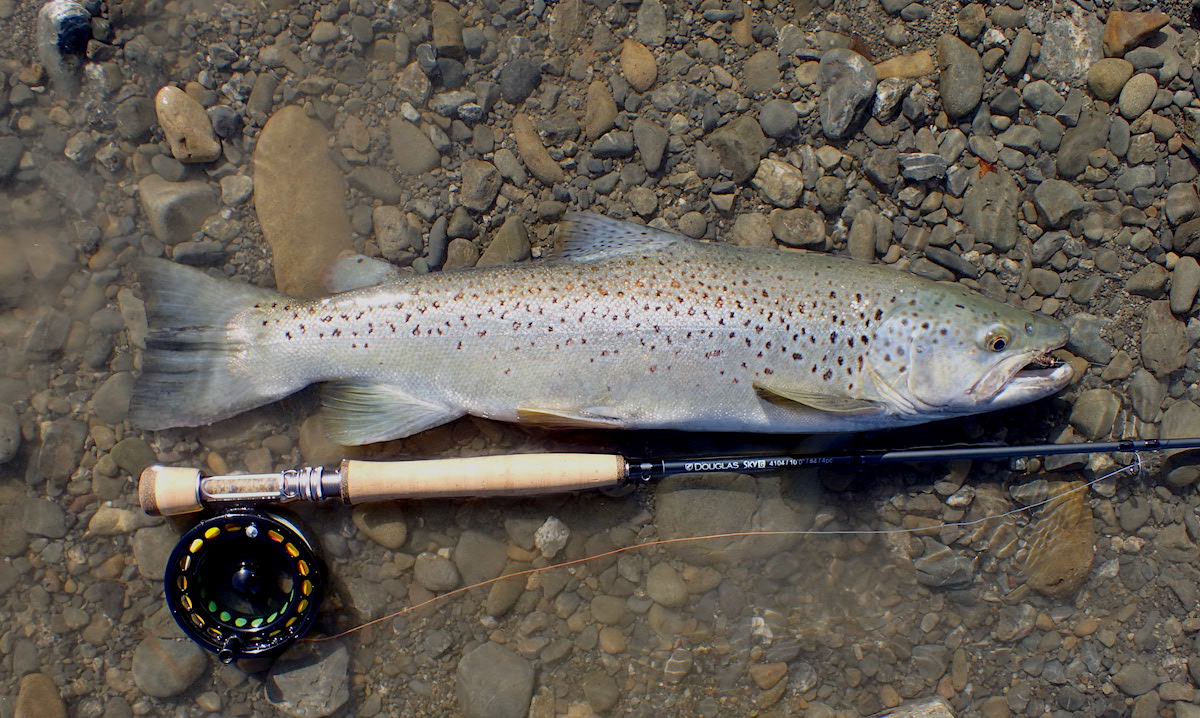
A decent brown trout, caught Euro nymphing with the SA Euro Kit and the Sky G 4104
Jig Streamers
Casting a jig streamer upstream and then jigging it along the bottom is an absolutely deadly technique for trout, perhaps because this best imitates the natural swimming action of bottom-dwelling baitfish such as bullies, torrent fish and sculpins.
This jigging technique is especially effective with a euro style outfit and mono rig because there’s no chance of lining fish and no drag from fly line or tapered leader to impede the enticing diving action.
Fishing jig streamers is not, however, limited to upstream casts and lifting and lowering the rod tip while keeping the line off the water as the fly comes back downstream.
I have had great success casting jig streamers some distance upstream, across or even downstream and then stripping the fly back with an erratic retrieve, while steering it with the rod tip. You still get the deadly dive and rise action.
Swinging the flies while raising and lowering the rod tip with a jiggle on the rise, is also effective.
Some anglers use very thin monofilament (down to 6 or 8 lb Chameleon) and heavy streamers so they can lob them - much like casting with a spinning rod.
Using a heavier stiff monofilament enables one to actually cast the streamers with modified fly casting techniques, which I prefer. These casts rely on both the pull of the streamer and push from the line.
Thicker monofilament is also great for stripping and is easier for handling the loose line when a good fish hits towards the end of a long retrieve and then takes off.
Another advantage of thicker mono is that it’s more easily mended on long casts to allow flies to sink to the required depth before swinging or stripping.
I tried jig streamers with 4.5 mm tungsten beads and 1/16 ounce lead jig hooks on the Sky G with three different mono rigs based on main lines of 35 lb OPST Lazar Line, 25 lb SA Flat Mono shooting line and 20 lb Maxima Chameleon.
The Sky G 4104 proved to have the right combination of flex, power and speed to be a very effective tool for casting (not lobbing) jig streamers with 4.0-4.5 mm tungsten beads.
I could cast an easy 40 feet with the 4.5mm tungsten bead streamer with Flat Mono or Lazar line, and with fewer false casts I could manage a good 50 ft with the 20 lb Chameleon rig.
Casting the mono rigs on the 10ft Sky G was much easier than casting them with a stiffer 9.5 ft 5wt Sage X, which is not regarded as a stiff 5wt rod. The 4wt loaded more deeply with the mono rig and jig streamer, and with a lot less effort.
The heavy streamer tied on a 1/16 ounce (6mm lead ball) jig hook felt a bit clunky on the Sky G, but sailed out even further than the 4.5 mm tungsten bead streamer, and with only one false cast.
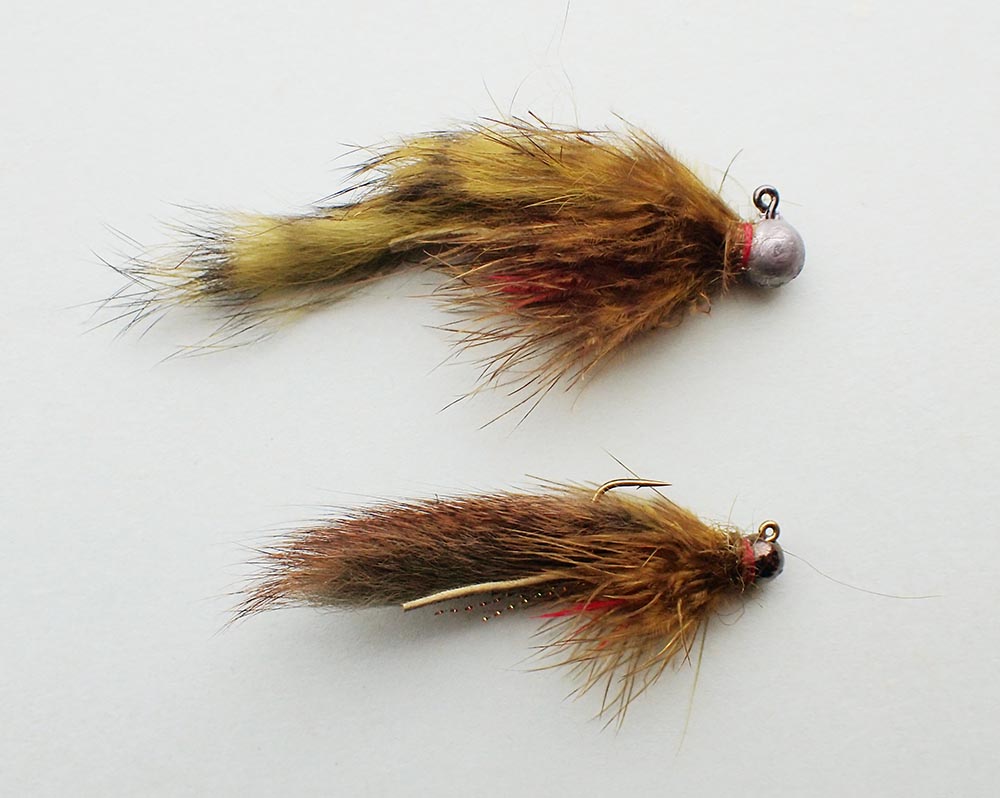
Jig streamers used on the mono rig with the Sky G 4104. The marabou collars slim down in the water and in addition to the deadly duck and dive action the mobile tails wiggle like crazy.
I was amazed by the accuracy I could achieve with the Sky G 4104, it was easily able to send the streamer underneath overhanging trees to within inches of the bank. I caught fish out of spots I could not effectively fish with a regular fly line or with Spey gear.
Wiggling the flexible rod tip whilst stripping, created some amazing swimming action to streamers with mobile tails.
Even though the tip of the Sky G 4104 is sensitive, there’s enough power to set the larger heavier gauge hooks typically used for streamer fishing.
My favourite dedicated streamer rig for the Sky G 4104 is the 20 lb Chameleon mono rig I mentioned earlier in the Euro Nymphing section. The section of 14 lb Maxima HV, provides just enough visibility to track the flies without spooking the fish.
When I’m switching back and forth between Spey Casting Skagit/Scandi heads and overhead casting jig streamers, I find it easier and quicker to loop onto the SA Flat mono running line a short leader consisting of around 1.5 ft each of 20 lb and 12 lb Chameleon with a tippet ring at the end.
I keep this short leader, with 5 ft of 3X fluorocarbon tippet attached, in my head wallet. The short leader provides good turn over and increases the distance of the brightly coloured running line from the fly.
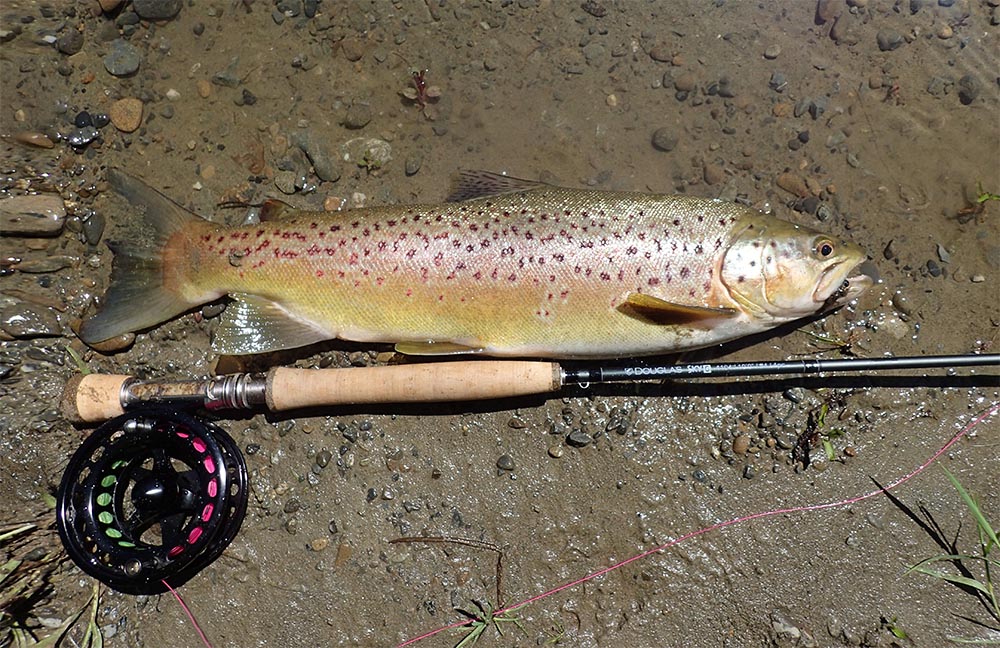
A brown trout caught on a jig streamer using OPST 35 lb Lazar line
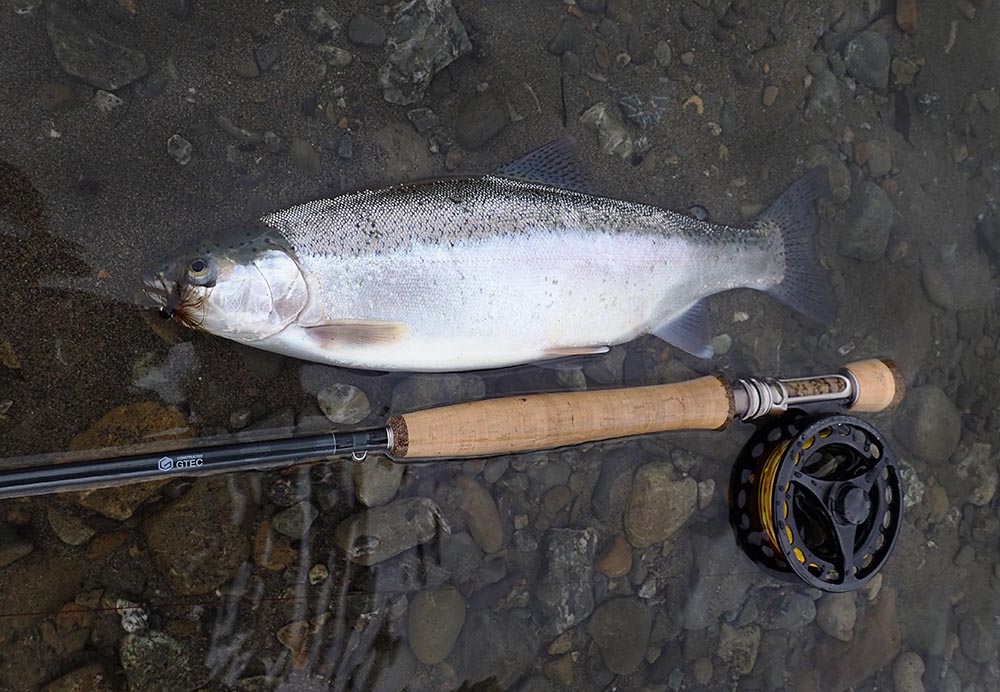
A chunky little New Zealand Steelhead taken from the tidal portion of a North Island river with a jig streamer on a Chameleon mono rig. There is no resident population of rainbow trout in this river.
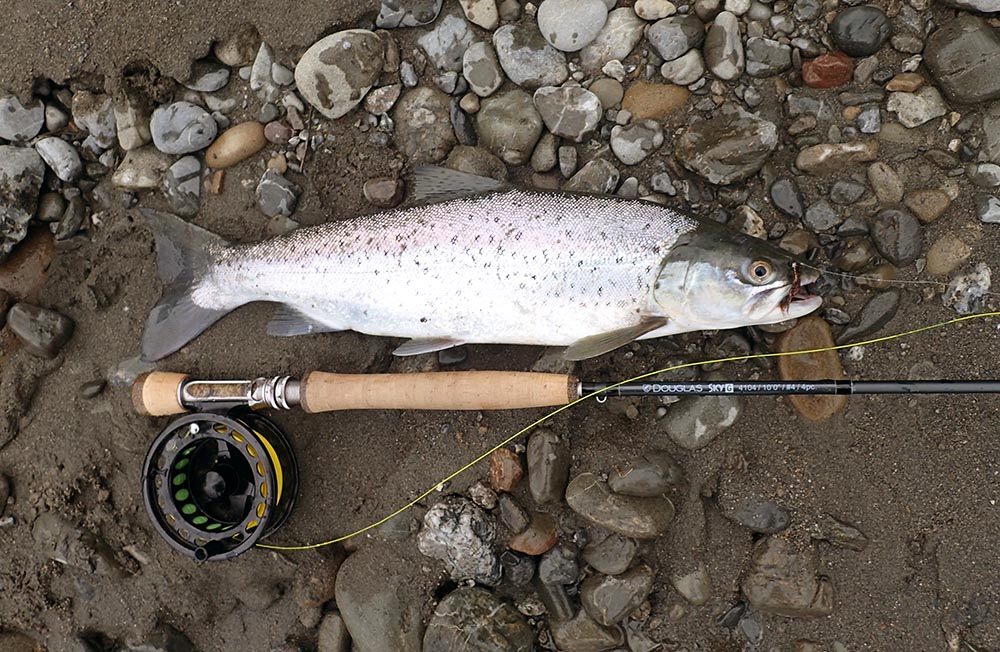
Sea trout caught on a jig streamer using the SA 25 lb flat mono
Regular Floating line
Euro nymphing is a close quarter’s technique that’s really effective in specific water types, but fails in others.
There are many occasions on local rivers when I come across good fish sitting in shallow water in the margins of large pools - classic New Zealand sight fishing.
You can’t get too close to these spooky fish, and the most effective technique is to cast a dry dropper rig above them from directly down stream. A long leader being essential.
Some euro rods cast regular floating lines better than others. When it comes to choosing a line there are two schools of thought, perhaps based on differences in rod action.
The first school reasons that Euro-nymph-rod line ratings are determined by the tip and that the butt is two sizes larger, so you up-line by one size when choosing a floating line, e.g. a 5wt line on a 4wt rod. The second school advocates a line weight equal to the rating for the rod.
Since I don’t have any 4wt lines I tried the following three 5wt lines: SA Creek Trout and SA textured Amplitude MPX and Infinity.
The Douglas Sky G 4104 has a medium fast action with a floating line and did not feel at all over-lined with any of the 5wt lines tested.
Most of the on-water testing was done with a dry fly and two nymphs on a leader with total length of 17 ft. Although I also tried a couple of nymphs below an indicator.
The long rod tracked exceptionally well and presentation with a dry dropper on a 17 ft leader was excellent, as well as surprisingly accurate for a 10 ft rod. Given this rod’s ridiculously low swing weight this did not feel like a 10 ft rod when casting.
The MPX and Infinity were great out to around 55 foot (30 feet of fly line out through the guides), but any casts longer than that were not so easy - the rod seemed to run out of steam. Casting in the park, I also became plagued by tailing loops when trying to make longer casts. Having said that, 55 feet easily covers regular fishing distances and almost all sight fishing situations.
Casts of 70 feet or more were easy with the Creek Trout, and tailing loops were never an issue when casting in the park. I attribute this to the long front taper and short (26 ft) heavy (160 grain) head. Greater weight in the first 26 feet of the Creek helped overcome the additional friction created by the extra guides, and made this line better in wind.
Putting more power into the back cast to load the long rod and then letting the rod do the work on the forward cast, produces a silky smooth delivery with excellent presentation.
I would try a 4wt version of the Creek Trout if I did a lot of fishing on rivers with regular hatches of #18 or #16 mayflies.
I ended up casting to a lot of sighted fish with the Sky G 4104 and a dry dropper rig. Because a 10 ft rod is a longer lever than the the 9 ft rods I am used to using, I had to adjust by using a softer shorter strike to avoid breaking off 5x fluorocarbon tippet. Striking horizontally, instead of vertically, also helped cushion the shock.
I mostly fished two nymphs beneath the dry fly, and the Sky G 4104 easily handled 2.5-3mm tungsten bead nymphs on the dropper with a lighter fly on the point. The three fly rig on a 17 foot leader was noticeably easier to use on a 10 ft versus 9 ft rod.
Apart from casting to sighted fish in gin clear water, one also comes across sections of river that are more suited to indicator than short line nymphing. The Sky G 4104 and each of the three 5wt lines easily cast a couple of 2.5 mm tungsten bead nymphs with a small yarn indicator.
The extra reach provided by the Sky G 10 ft rod allowed me to keep more line off the water than I can with a 9 ft rod and also made for easy mending, and it stack-mends like a machine.
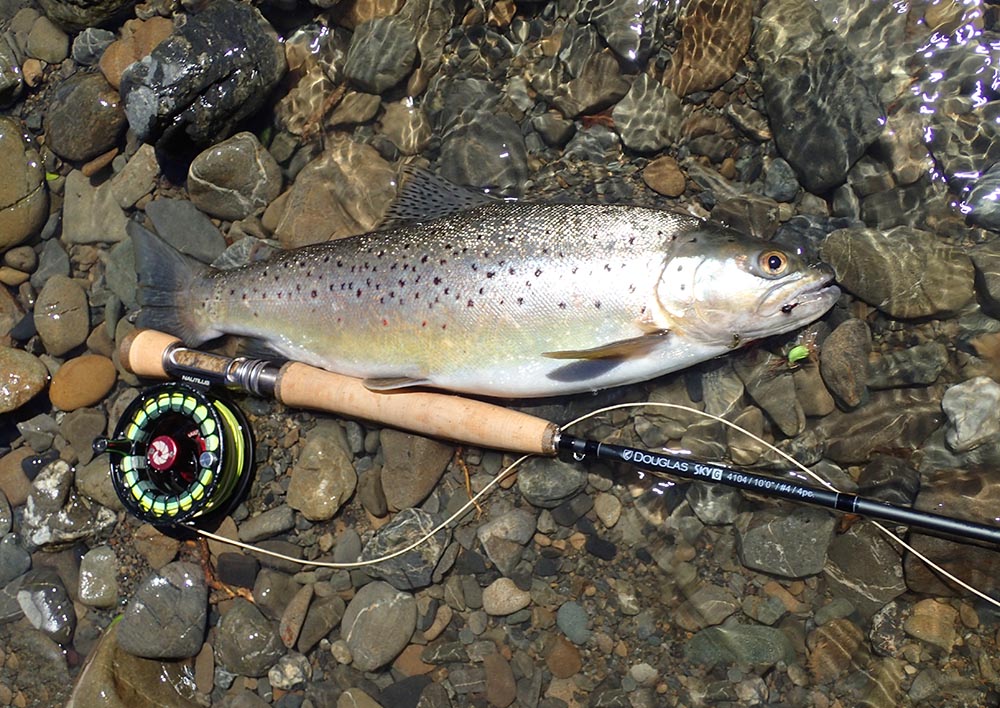
Sight fishing with the Sky G 4104 and dry dropper rig on a regular 5wt floating line (SA textured MPX)
Skagit and Scandi heads
The Sky G 4104 is an exceptional single hand Spey Casting tool, it has the perfect length and flex profile for this purpose. This rod with the 5wt Creek Trout, essentially an integrated Scandi head, is my new favourite soft hackle outfit; great for swinging dries and emergers during the evening caddis hatch, especially where there is little room for a back cast.
Spey Casting is often an advantage when fishing a team of soft hackles, and a 10 ft rod makes for easier mending, fly manipulation and fewer tangles. The soft tip on the Sky G also protects light tippets from solid takes on a tight line.
Another line that’s great for swinging soft hackles and dries is a 150 grain SA Scandi Lite with or without 5ft Poly Leaders. With a 25 lb SA flat mono running line and the Scandi Lite the Sky G was a sublime smooth-casting distance machine.
The difference in distance between integrated fly lines and mono running lines is perhaps more noticeable on Euro rods because they have more guides, which with coated running lines equates to more friction.
The 150 grain Scandi Lite and 5 ft Polyleader proved to be an effective combination for fishing white bait patterns for sea trout in the lower reaches and estuaries of New Zealand rivers in Spring and early Summer. Distance is often an advantage in this scenario.
For swinging streamers I tried:
1. an 11 foot 150 grain SA Skagit Lite head with a 50g grain S6 Sonar leader and
2. an 18 ft 185 grain Guide 3D+ ULS head in S1/S3/S5 configuration, to which I added a three foot S6 tip (made from the butt of a Sonar leader).
Both head systems cast extremely well on 25 lb SA flat mono shooting line, and distances of 60-70 feet were easy with both touch-and-go and sustained-anchor casts. Snake rolls and single Speys were so much fun on these outfits.
The ULS head achieved more depth than the Skagit head and sink tip, and is a good choice for deeper pools and faster water.
Massive streamers can’t be cast on these light head-systems, but #8 and #6 weighted woolly buggers and small tube flies are no trouble at all, and one doesn’t need much more than that in New Zealand.
Fighting fish
The Sky G 4104 has plenty of power in the butt section and I really appreciated the fighting butt, which I used to brace the rod against my forearm, the heel of my reel hand or my chest, when fighting decent fish.
The progressive flex on the Sky G 4104 is most apparent with a decent fish on - there’s no sharp transition between tip and butt section. The deep flex means there’s a lot of ‘springy’ shock absorption to protect light tippets and maintain tension with barbless hooks.
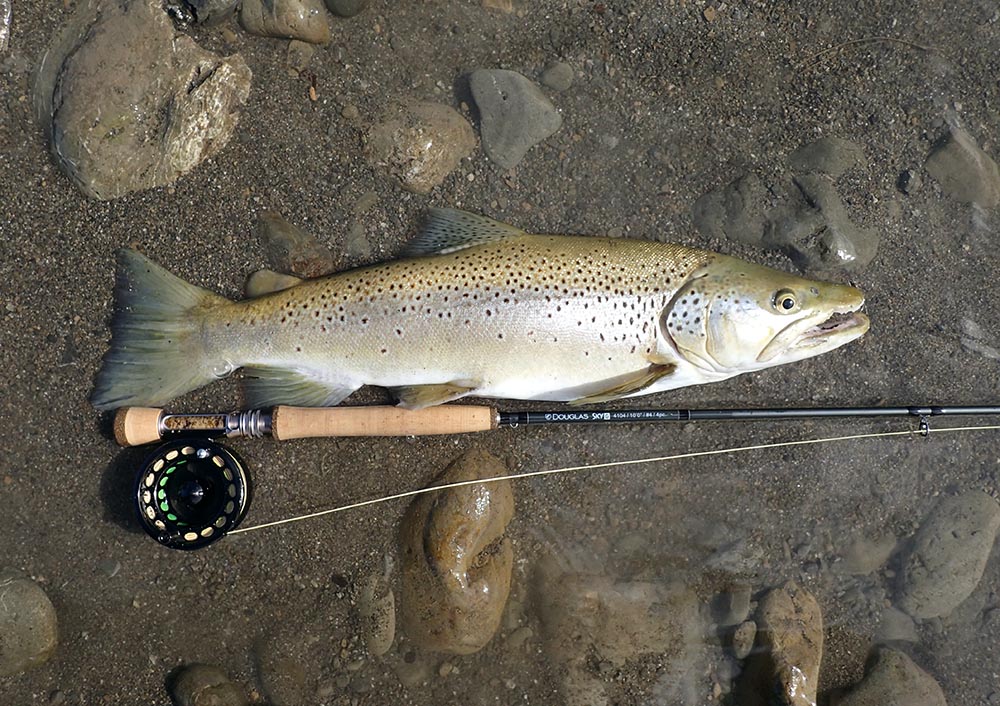
The Sky G 4104 had plenty of power to handle strong fish in big water, but enough flex and sensitivity to land them on 5X tippet. This one was caught using using a dry-dropper and SA Infinity 5wt floating line.
Pros and Cons of a versatile rod
Fishing success on New Zealand rivers usually involves covering lots of water, and having the option of using different techniques is a big advantage. Carrying two rods can be frustrating with having to go back downstream to retrieve the rod not being used. And there's always the risk of leaving a rod on the river!
With the Sky G 4104 I don’t need a second rod.
A typical spring day on a local river could start early with swinging streamers on a light Skagit or Scandi head for sea trout. I might then switch to a jig streamer on a mono rig to present the fish with something different and to reach places I could not on the swing.
After the sea-trout session I usually make my way upstream: Euro-nymphing deeper pockets and runs and if I start spotting fish in the shallows, I switch to a floating line and a dry dropper.
On larger rivers I like to extend my reach on areas of even flow by indicator nymphing with the floating line, or switch to soft hackles, especially if a hatch develops.
At the end of the day I have the option of putting the Skagit or Scandi head back on and swinging my way back to the car.
The Sky G 4104 does all of this exceedingly well.
The ability to Euro nymph, indicator nymph or swing streamers or emergers and dry flies on Skagit/Scandi heads also means I can cover all aspects of fishing the Tongariro River in summer with just one rod.
Of course no rod is the best at everything, and as with any versatile stick there are some compromises in certain areas and advantages in others.
Beginning with the cons:
Compared to my regular 9 ft 5wt rod, I am a little less accurate when casting the dry dropper on standard floating lines to sighted fish on the Sky G 4104 - 10 ft rods are just not as accurate as 9 ft rods.
The extra friction created by the additional guides may require an extra false cast with a floating fly line, and the medium fast action is perhaps not the best for strong wind.
These ‘cons’ did not prevent me catching a lot of sighted fish with a dry dropper in tough conditions.
10 ft rods commonly increase swing weight, but the Sky G 4104 is so incredibly light I was not aware of any extra weight.
Now for the pros:
The flex and additional length of the Sky G 4104 meant:
1. Better distance with streamers on mono rigs and when Spey Casting, particularly with mono running lines.
2. Better control of: the drift when indicator nymphing; the swing when fishing Skagit/Scandi heads; the movement of streamers on mono rigs.
3. Better at casting and fishing nymphs on euro gear - which is what it is designed for.
A versatile reel system
The cool thing about a versatile 10 ft rod like the Sky G 4104 is that you only need one reel and a spare spool to cover all options.
On one spool of my Danielsson F3W I have a 25 lb SA Flat Mono running line to which I can attach a Skagit head, a Scandi head, a short euro nymphing line or a mono rig based on 20 lb Chameleon. I can also add a short leader for jig streamers, essentially turning the running line into a mono rig. And swapping lines only takes a couple of minutes.
On the spare spool of the Danielsson I have the regular floating line.
If you intend to only use a mono rig and a regular floating line, the mono rig can be attached directly to the floating line, so no spare spool is required.
A full cage reel is recommended for mono running lines, mono rigs and thin euro lines, as it provides more weight for balancing longer rods and prevents thin lines from squeezing between the spool and the frame.
Warranty
What makes the Douglas Sky G warranty so good is that the company doesn’t need to see the rod, they simply replace the broken section, free of charge if deemed to be a factory fault or for NZ$ 160 if due to user error.
Most other high end rods need to be shipped back to the USA for repair, a process that in my experience can take five to six months.
Flyshop NZ carries most parts for popular models of the Douglas Sky G series, so if you break a tip you should be back fishing within 2 - 3 days. If the part has to be ordered in, then you are looking at about two to three weeks.
Conclusion
The Sky G 4104’s brilliant performance comes from its incredibly light swing weight, uncanny sensitivity, fast recovery and smooth integration from soft sensitive tip to powerful butt section.
It is now the most versatile rod I own and a no-brainer for days when I plan to use several techniques, including casting dry flies and nymphs to visible fish, or even indicator nymphing. This is also the rod I reach for when, Euro nymphing, fishing streamers on mono rigs and single hand Spey casting.
As a Trout Spey rod, the Sky G 4104 has the delicacy and finesse of a 1wt double hander but with the ability to handle much larger fish. It casts the same Scandi and Skagit heads as my 9 ft 5wt presentation rods do, but the extra length means it casts further and also allows better control of the swing.
As a Euro nymphing tool, the Sky G 4104 is an extremely light and sensitive 4wt. It handles a wide range of nymph weight and fish size, and is suitable for everything from New Zealand lowland rivers to Taupo tributaries, essentially covering the bases of both 3wt and 4wt rods.
The combination of length, flex and power make it an excellent rod for casting jig streamers on mono rigs.
After using the amazing 4104 for four months it was easier for me to part with some hard-earned cash than to part with this rod.
Thanks to Steve Gerard from Feather Merchants NZ for providing the Sky G 4104 for testing.
Update - April 2025
During 2024 I extensively tested SA textured Amplitude 5wt Double Taper and Trout fly lines on the 10 ft Sky G 4wt. The DT has become my favourite floating line for this rod. For more on how the Trout and DT performed on the Sky G 4104, see this review :
See other reviews :
